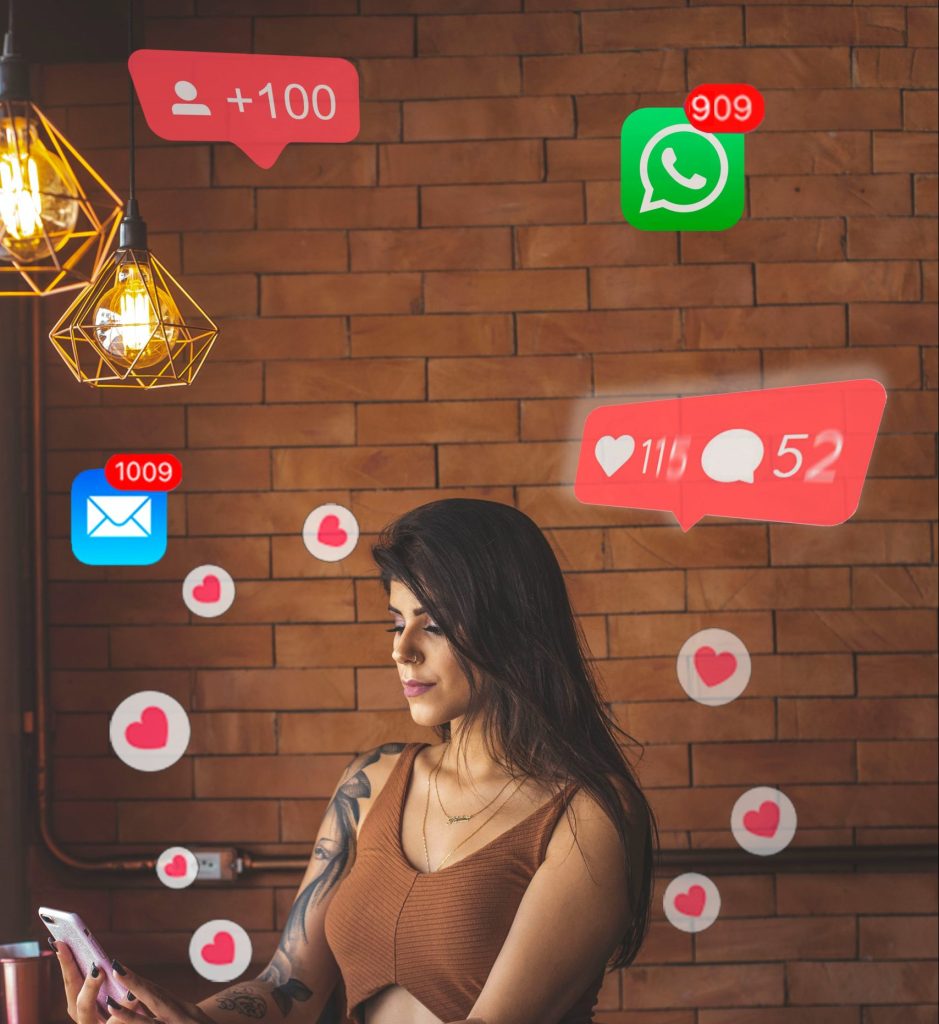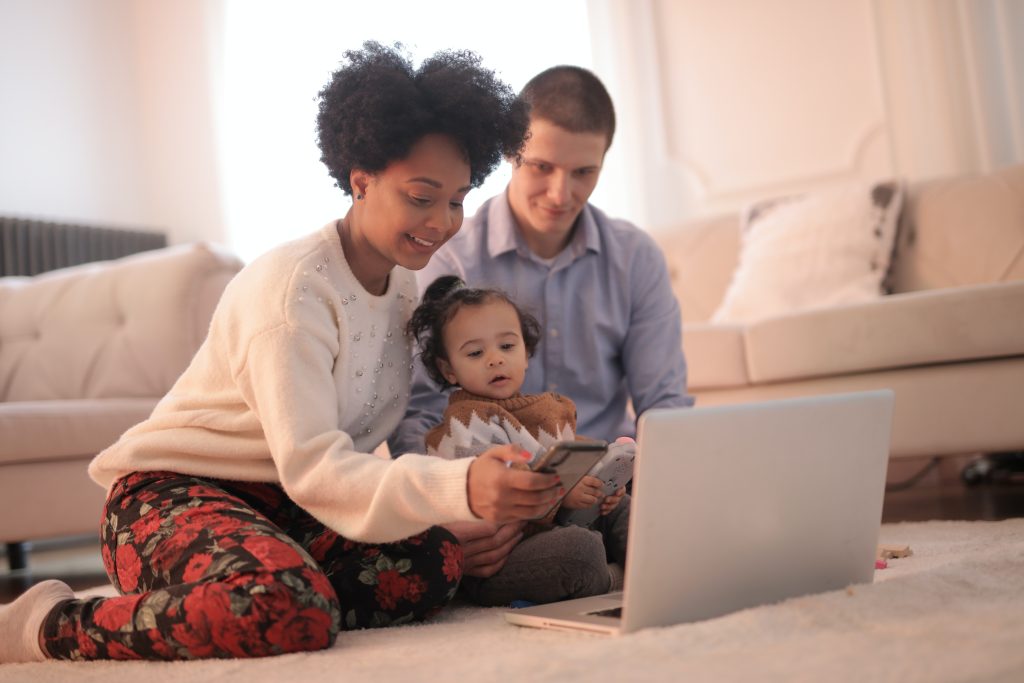12 It’s the End of the World as We Know It
Revisiting Lingo
As you will recall, Lingo appeared in a previous chapter. Lingo has been maintaining their relationships with family and friends in another country, but it has been very hard due to physical distance and different time zones. Lingo has tried dating apps to find a romantic partner. Dating apps have allowed Lingo to communicate in an anonymous and confidential way. By communicating via text messages, no one can see or hear Lingo’s cultural differences. Lingo loves this technology but is only disappointed when the interaction moves from online to offline. Online Lingo can be savvy and charming because they have time to craft their words, but in person, Lingo finds it hard to say the right thing without using translation apps and googling for the perfect thing to say. When Lingo finally finds someone they are highly attracted to, that person wants to find multiple partners, because dating apps have allowed for the opportunity to find more potential dating partners online. Also, this person likes to post mean things on their social media platforms. Lingo loves that they can meet new people online but also hates how people can be cruel on these platforms as well.
What’s on the horizon?
Interpersonal relationships have been a crucial part of human existence since the beginning of time. As technology continues to advance and societies evolve, the way we form and maintain relationships is also changing. In this chapter, we will explore the future of interpersonal relationships, the impact of technology on relationships, and the potential challenges and opportunities that lie ahead.
12.1 The Future of Interpersonal Relationships
As we move forward into the future, the landscape of interpersonal relationships is expected to undergo significant changes. One of the most notable changes is the increasing use of technology in communication, which has already begun to transform the way we interact with each other. Social media platforms, instant messaging apps, and video conferencing tools have made it easier than ever to connect with people from all over the world in real time (Farris et al., 2021).
While technology has brought many benefits to our relationships, it has also created new challenges that we must navigate. One of the biggest challenges is the potential for miscommunication. When we communicate electronically, we lose the ability to read nonverbal cues, such as tone of voice and body language, which can lead to misunderstandings and conflict.
Another trend that is likely to shape the future of interpersonal relationships is the growing importance of emotional intelligence. As we become more aware of the importance of mental health and well-being, people are beginning to prioritize emotional intelligence as a key component of healthy relationships. This means being able to understand and manage our own emotions, as well as being able to empathize with and respond to the emotions of others.
Finally, as we continue to grapple with the challenges posed by the COVID-19 pandemic, we can expect to see a shift towards more intentional and mindful forms of communication. The pandemic has forced us to reevaluate the way we interact with others, and many people are now placing a greater emphasis on building deeper and more meaningful relationships.
Overall, the future of interpersonal relationships is likely to be shaped by a combination of technological advancements, changing social norms, and evolving attitudes toward emotional intelligence and mental health. While there are certainly challenges ahead, there are also many opportunities for growth and connection as we navigate this new terrain together.

What do you think your relationships will look like 5 years from now? What about 10?
12.2 The Impact of Technology on Relationships
Technology has significantly impacted interpersonal relationships in various ways (Cao et al., 2020). The rise of social media and messaging applications has made it easier to connect with people from all over the world, regardless of geographic location. In addition, technology has provided a community or a place of connection for people (e.g., queer people living in rural areas, or disabled people who may not otherwise be able to be in the community). It has also enabled people to communicate more frequently and in new ways, such as through video calls or instant messaging. However, there are also some negative impacts that technology can have on relationships.
One of the most significant impacts of technology on relationships is the potential for addiction (Punyanunt-Carter et al., 2017). People can become addicted to their devices, spending hours scrolling through social media or messaging apps instead of spending time with the people in their lives. This can lead to feelings of loneliness and disconnection, even when surrounded by others.
Another negative impact of technology is the potential for miscommunication. Text-based communication can be easily misinterpreted, leading to misunderstandings and conflicts. Additionally, people may rely too heavily on technology to communicate, avoiding face-to-face conversations that can be more meaningful and effective (Punyanunt-Carter, et al., 2018).
On the other hand, technology has also made it easier to maintain long-distance relationships. Video calls and messaging apps can help couples and families stay connected even when they are far apart. Technology has allowed people to post on social media so that they can still feel a sense of connection when the other person is far away.
Additionally, social media can help people form new relationships and connect with others who share similar interests. Online dating, while providing new opportunities for romantic relationships, has also been linked to increased feelings of rejection and decreased levels of self-esteem. The “swipe culture” of dating apps has been criticized for encouraging superficiality and making it harder to form meaningful connections.
Additionally, technology has led to new forms of cyberbullying and harassment, which can have a significant impact on interpersonal relationships. The anonymity provided by online interactions can lead to more aggressive behavior and can make it harder for victims to seek help and support.
Looking to the future, technology is likely to continue to play a significant role in interpersonal relationships. As technology continues to advance, new communication tools and platforms will emerge, making it easier than ever to connect with others. However, it will be important for people to use technology responsibly and avoid becoming overly dependent on it, in order to maintain healthy and fulfilling relationships both online and offline.
Are you addicted to social media?
- Take a quiz here to find out.
- Are you aware of your average screen time per day?
- What are some ways you could take time to step away from screens?
12.3 The Future: Challenges and Opportunities
As we look to the future of interpersonal relationships, it is important to consider the potential challenges and opportunities that lie ahead. While technology can provide new opportunities for connection and interaction, it is important to be aware of its potential negative impacts (Sun & Zhang, 2021).
One of the challenges of the future of interpersonal relationships is how to balance the benefits of technology with its potential negative effects. This may involve developing new technologies that prioritize meaningful connections and encourage positive social interactions while mitigating the negative impacts of excessive technology use.
Another challenge is ensuring that technology does not replace face-to-face interactions and human connection. While technology can facilitate connections, it cannot replace the value of in-person interactions and human touch. As in our example, Lingo still felt the need to interact with others and find relationships. As human beings, we are social creatures, and we still have a need to be around other human beings.
On the other hand, the future of interpersonal relationships also presents new opportunities for connection and community. The rise of virtual reality and augmented reality technologies may allow us to form deeper connections with others and experience new forms of social interaction. It is easier than ever to connect with other people who have similar interests and passions. There are tons of websites and online communities that can bring like-minded individuals together.
Furthermore, as we become more aware of the potential negative impacts of technology on interpersonal relationships, we may also become more intentional about our social interactions. This could lead to a renewed emphasis on meaningful connections and a greater appreciation for face-to-face interactions.
Reflection Questions
- How would you describe the benefits of social media on interpersonal relationships?
- How would you describe the potentially negative impacts of social media on interpersonal relationships?
12.4 Benefits of Social Media on Interpersonal Relationships
Social media has revolutionized the way we communicate and interact with others (Sundar, & Limperos, 2013). There are many benefits to using social media that can actually enhance these relationships, such as connection, meeting new people, reducing social anxiety, and strengthening current relationships (Sundar & Limperos, 2013).
One major benefit of social media on interpersonal relationships is the ability to stay connected with friends and family who are far away. In the past, people would lose touch with loved ones who lived in other cities or countries. But now, with social media platforms like Facebook, Instagram, and Twitter, it’s easy to stay in touch with people regardless of where they live. This has made it possible for people to maintain stronger and more meaningful relationships with those who they might have otherwise lost touch with.
Another benefit of social media on interpersonal relationships is the ability to meet new people and form new relationships. Social media platforms like LinkedIn and Meetup allow people to connect with others who share similar interests or professional goals. This can lead to the formation of new friendships, business partnerships, or romantic relationships that might not have been possible otherwise.
Social media can also help improve communication skills and reduce social anxiety. For introverted individuals, social media provides a comfortable and non-threatening way to engage with others and express their thoughts and ideas. This can help them build confidence in their social skills and eventually lead to more meaningful and fulfilling interpersonal relationships in real life.
Finally, social media can be a powerful tool for strengthening existing relationships. Couples can use social media to share photos, videos, and updates about their lives, which can help keep the relationship fresh and exciting. Additionally, social media can provide a way for couples to communicate with one another throughout the day, even when they are physically apart. In Lingo’s situation, they can keep in contact with several friends and family at one time rather than contacting each person individually.

What do you think younger generations are experiencing as they grow up with technology?
12.5 The Drawbacks of Social Media on Interpersonal Relationships
Despite its benefits, social media has also been criticized for its negative impact on interpersonal relationships (Brooks, 2015). One of the most significant drawbacks is the potential for social media to replace face-to-face interactions. As people become more reliant on social media for communication, they may become less likely to engage in in-person interactions. This can lead to feelings of loneliness and isolation, particularly among younger generations.
Social media can also create a false sense of connection, particularly in the case of romantic relationships. It can be easy to misinterpret online interactions, and the lack of nonverbal cues can make it difficult to accurately interpret someone’s intentions or emotions. This can lead to misunderstandings and can make it harder to form deep, meaningful connections. Examples of a false sense of connection can be seen on shows like Catfish and Ghosted.
Social media can create a culture of comparison and envy, where people are constantly comparing their lives to others and feeling inadequate as a result. This can strain interpersonal relationships, as people may become jealous or resentful of others who seem to have more success or happiness. When people constantly see images of happy people, they may start to second-guess their own lives and their own sense of worth (Rasmussen et al, 2020).
In addition, it has been found that people tend to overshare information on social media (Brammer et al., 2022). In other words, people will self-disclose more than what is appropriate or necessary. Understanding why people do this online will help us understand how people communicate in face-to-face situations. It is quite possible that our online behaviors are affecting our in-person behaviors and what we think is suitable in social situations.
While social media can create the illusion of connection, it can also create a false sense of intimacy that may not actually exist in real life. This can lead to disappointment and disillusionment when people finally meet face-to-face. Another potential drawback of social media is the impact it can have on mental health (Rasmussen, et al., 2020). Studies have shown that excessive social media use can lead to increased levels of anxiety, depression, and loneliness. It can also create a sense of “FOMO” (fear of missing out), leading people to compare themselves to others and feel inadequate (Przybylski, et al. 2013).
12.6 Practicing Healthful Skills
As social media continues to evolve, it is likely that its impact on interpersonal relationships will also change. One potential area of growth is the use of social media in mental health support. As more people seek emotional support online, there may be opportunities to develop new platforms that provide more personalized support and guidance.
Another potential area of growth is the use of social media in professional relationships. Social media platforms like LinkedIn are already being used to connect professionals with one another, and this trend is likely to continue. As more people use social media for professional purposes, it may become increasingly important to understand the nuances of online communication and how to form meaningful connections in a virtual setting. Online is not only where people are finding love, but also employment.
All in all, social media has had a significant impact on interpersonal relationships, both positive and negative (Punyanunt-Carter, et al.,2018). While it has allowed us to form connections with people from all over the world and maintain existing relationships, it has also been criticized for its potential to replace face-to-face interactions and create a false sense of connection. As social media continues to evolve, it is important to understand its impact on interpersonal relationships and to develop strategies for using it in a way that supports meaningful, authentic connections.
The Chapter 12 Mixtape
-
-
-
-
New Order – “Blue Monday”
-
NWA – “Straight Outta Compton”
-
Kate Bush – “Cloudbusting”
-
Ziggy Marley – “Tomorrow People”
-
David Bowie – “Modern Love”
-
-
-
Chapter References
Brammer, S. E., Punyanunt-Carter, N. M., & Duffee, R.S. (2022). Oversharing on social networking sites: A contemporary communication phenomenon. Computers in Human Behavior Reports, 8, 100236-100240. https://doi.org/10.1016/j.chbr.2022.100236
Brooks, S. (2015). Does personal social media usage affect efficiency and well-being?. Computers in Human Behavior, 46, 26-37. https://doi.org/10.1016/j.chb.2014.12.053
Cao, X., Gong, M., Yu, L., & Dai, B. (2020). Exploring the mechanism of social media addiction: An empirical study from WeChat users. Internet Research, 30(4), 1305-1328. https://doi.org/10.1108/INTR-08-2019-0347
Ferris, A. L., Hollenbaugh, E. E., & Sommer, P. A. (2021). Applying the uses and gratifications model to examine consequences of social media addiction. Social Media + Society, 7(2), 20563051211019003.
Przybylski, A. K., Murayama, K., DeHaan, C. R., & Gladwell, V. (2013). Motivational, emotional, and behavioral correlates of fear of missing out. Computers in Human Behavior, 29(4), 1841-1848. https://doi.org/10.1016/j.chb.2013.02.014
Punyanunt-Carter, N. M., Delacruz, J. J., & Wrench, J. S. (2017). Investigating the relationships among college students’ satisfaction, addiction, needs, communication apprehension, motives, and uses & gratifications with Snapchat. Computers in Human Behavior. 75, 870-875. https://doi: 10.1016/j.chb.2017.06.034
Punyanunt-Carter, N. M., De La Cruz, J. J, & Wrench, J. S. (2018). Analyzing college students’ social media communication apprehension. Cyberpsychology, Behavior, and Social Networking, 21(8), 511-515. https://doi.org/10.1089/cyber.2018.0098
Rasmussen, E. E., Punyanunt-Carter, N., La Freniere, J. R., Norman, M. S., & Kimball, T. G. (2020). The serially mediated relationship between emerging adults’ social media use and mental well-being. Computers in Human Behavior, 102, 206-213. https://doi.org/10.1016/j.chb.2019.08.019
Sun, Y., & Zhang, Y. (2021). A review of theories and models applied in studies of social media addiction and implications for future research. Addictive Behaviors, 114, 106699. https://doi.org/10.1016/j.addbeh.2020.106699
Sundar, S. S., & Limperos, A. M. (2013). Uses and Grats 2.0: New gratifications for new media. Journal of Broadcasting & Electronic Media, 57(4), 504-525. https://doi.org/10.1080/08838151.2013.845827


